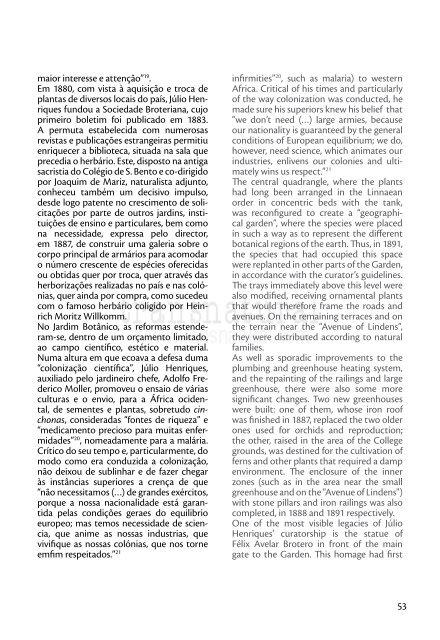Jardim Botânico de Coimbra: contraponto entre a Arte e a ... - artez
Jardim Botânico de Coimbra: contraponto entre a Arte e a ... - artez
Jardim Botânico de Coimbra: contraponto entre a Arte e a ... - artez
Create successful ePaper yourself
Turn your PDF publications into a flip-book with our unique Google optimized e-Paper software.
maior interesse e attenção” 19 .<br />
Em 1880, com vista à aquisição e troca <strong>de</strong><br />
plantas <strong>de</strong> diversos locais do país, Júlio Henriques<br />
fundou a Socieda<strong>de</strong> Broteriana, cujo<br />
primeiro boletim foi publicado em 1883.<br />
A permuta estabelecida com numerosas<br />
revistas e publicações estrangeiras permitiu<br />
enriquecer a biblioteca, situada na sala que<br />
precedia o herbário. Este, disposto na antiga<br />
sacristia do Colégio <strong>de</strong> S. Bento e co-dirigido<br />
por Joaquim <strong>de</strong> Mariz, naturalista adjunto,<br />
conheceu também um <strong>de</strong>cisivo impulso,<br />
<strong>de</strong>s<strong>de</strong> logo patente no crescimento <strong>de</strong> solicitações<br />
por parte <strong>de</strong> outros jardins, instituições<br />
<strong>de</strong> ensino e particulares, bem como<br />
na necessida<strong>de</strong>, expressa pelo director,<br />
em 1887, <strong>de</strong> construir uma galeria sobre o<br />
corpo principal <strong>de</strong> armários para acomodar<br />
o número crescente <strong>de</strong> espécies oferecidas<br />
ou obtidas quer por troca, quer através das<br />
herborizações realizadas no país e nas colónias,<br />
quer ainda por compra, como suce<strong>de</strong>u<br />
com o famoso herbário coligido por Heinrich<br />
Moritz Willkomm.<br />
No <strong>Jardim</strong> <strong>Botânico</strong>, as reformas esten<strong>de</strong>ram-se,<br />
<strong>de</strong>ntro <strong>de</strong> um orçamento limitado,<br />
ao campo científico, estético e material.<br />
Numa altura em que ecoava a <strong>de</strong>fesa duma<br />
“colonização científica”, Júlio Henriques,<br />
auxiliado pelo jardineiro chefe, Adolfo Fre<strong>de</strong>rico<br />
Moller, promoveu o ensaio <strong>de</strong> várias<br />
culturas e o envio, para a África oci<strong>de</strong>ntal,<br />
<strong>de</strong> sementes e plantas, sobretudo cinchonas,<br />
consi<strong>de</strong>radas “fontes <strong>de</strong> riqueza” e<br />
“medicamento precioso para muitas enfermida<strong>de</strong>s”<br />
20 , nomeadamente para a malária.<br />
Crítico do seu tempo e, particularmente, do<br />
modo como era conduzida a colonização,<br />
não <strong>de</strong>ixou <strong>de</strong> sublinhar e <strong>de</strong> fazer chegar<br />
às instâncias superiores a crença <strong>de</strong> que<br />
“não necessitamos (…) <strong>de</strong> gran<strong>de</strong>s exércitos,<br />
porque a nossa nacionalida<strong>de</strong> está garantida<br />
pelas condições geraes do equilibrio<br />
europeo; mas temos necessida<strong>de</strong> <strong>de</strong> sciencia,<br />
que anime as nossas industrias, que<br />
vivifique as nossas colónias, que nos torne<br />
emfim respeitados.” 21<br />
infirmities” 20 , such as malaria) to western<br />
Africa. Critical of his times and particularly<br />
of the way colonization was conducted, he<br />
ma<strong>de</strong> sure his superiors knew his belief that<br />
“we don’t need (…) large armies, because<br />
our nationality is guaranteed by the general<br />
conditions of European equilibrium; we do,<br />
however, need science, which animates our<br />
industries, enlivens our colonies and ultimately<br />
wins us respect.” 21<br />
The central quadrangle, where the plants<br />
had long been arranged in the Linnaean<br />
or<strong>de</strong>r in concentric beds with the tank,<br />
was reconfigured to create a “geographical<br />
gar<strong>de</strong>n”, where the species were placed<br />
in such a way as to represent the different<br />
botanical regions of the earth. Thus, in 1891,<br />
the species that had occupied this space<br />
were replanted in other parts of the Gar<strong>de</strong>n,<br />
in accordance with the curator’s gui<strong>de</strong>lines.<br />
The trays immediately above this level were<br />
also modified, receiving ornamental plants<br />
that would therefore frame the roads and<br />
avenues. On the remaining terraces and on<br />
the terrain near the “Avenue of Lin<strong>de</strong>ns”,<br />
they were distributed according to natural<br />
families.<br />
As well as sporadic improvements to the<br />
plumbing and greenhouse heating system,<br />
and the repainting of the railings and large<br />
greenhouse, there were also some more<br />
significant changes. Two new greenhouses<br />
were built: one of them, whose iron roof<br />
was finished in 1887, replaced the two ol<strong>de</strong>r<br />
ones used for orchids and reproduction;<br />
the other, raised in the area of the College<br />
grounds, was <strong>de</strong>stined for the cultivation of<br />
ferns and other plants that required a damp<br />
environment. The enclosure of the inner<br />
zones (such as in the area near the small<br />
greenhouse and on the "Avenue of Lin<strong>de</strong>ns")<br />
with stone pillars and iron railings was also<br />
completed, in 1888 and 1891 respectively.<br />
One of the most visible legacies of Júlio<br />
Henriques’ curatorship is the statue of<br />
Félix Avelar Brotero in front of the main<br />
gate to the Gar<strong>de</strong>n. This homage had first<br />
53


